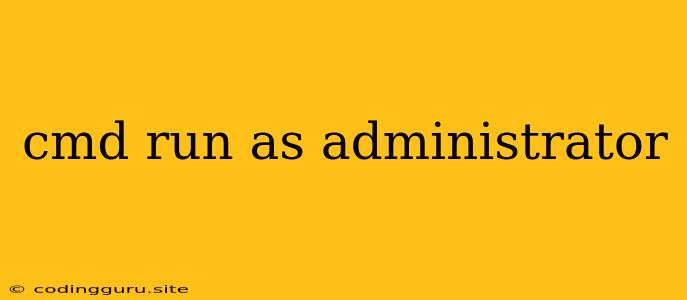Running Command Prompt as Administrator: A Comprehensive Guide
Have you ever encountered a situation where you need to make changes to your system, but you are met with an error message stating you lack the necessary permissions? This is a common issue faced by many computer users. The solution often lies in running Command Prompt as an administrator.
What is Command Prompt?
Command Prompt, also known as cmd.exe, is a powerful tool built into Windows operating systems that allows you to interact with your computer using text-based commands. It provides a command-line interface, offering a more direct way to control your system compared to the graphical user interface.
Why Run Command Prompt as Administrator?
When you run Command Prompt as an administrator, you grant it elevated privileges. This means it can access and modify system files and settings that are otherwise protected, allowing you to perform actions that require administrative permissions, such as:
- Installing or uninstalling software: Many software installations require administrative privileges to write files to system directories.
- Modifying system settings: Changing system-wide configurations or user accounts often requires administrative access.
- Running specific commands: Some commands, especially those related to system maintenance or troubleshooting, necessitate elevated privileges.
How to Run Command Prompt as Administrator
There are several ways to run Command Prompt as administrator:
1. Using the Start Menu:
- Press the Windows key on your keyboard.
- Type "cmd" in the search bar.
- Right-click on "Command Prompt" and select "Run as administrator".
2. Using File Explorer:
- Open File Explorer (Windows key + E).
- Navigate to the C:\Windows\System32 folder.
- Locate "cmd.exe".
- Right-click on it and select "Run as administrator".
3. Using the Shortcut:
- Right-click on your desktop and select "New" -> "Shortcut".
- In the "Type the location of the item:" field, paste the following path: %SystemRoot%\system32\cmd.exe.
- Click Next, give the shortcut a name like "Administrator Command Prompt", and finish.
- Right-click on the shortcut and select "Properties".
- Go to the "Shortcut" tab.
- In the "Target" field, add a space at the end and then type: /admin.
- Click Apply and OK.
- Now, you can simply double-click the shortcut to launch Command Prompt as administrator.
Common Uses of Command Prompt as Administrator
Here are some common scenarios where running Command Prompt as administrator comes in handy:
- Troubleshooting network connectivity issues: Commands like
ipconfigandpingcan be used to diagnose and resolve network problems. - Fixing system errors: Commands like
sfc /scannowandchkdskcan help repair corrupted system files and identify hard drive errors. - Managing user accounts: You can create, delete, and modify user accounts using commands like
net user. - Running system utilities: Commands like
diskpartandregeditallow you to manage disk partitions and edit the registry.
Tips for Using Command Prompt as Administrator
- Be careful: Always double-check the commands you enter before running them, as they can potentially damage your system if used incorrectly.
- Use caution with system-level commands: Only execute commands that you fully understand, as they can have significant consequences.
- Consult online resources: For detailed information and guidance on specific commands, refer to Microsoft's official documentation or reputable online resources.
Conclusion
Running Command Prompt as administrator is an essential skill for any Windows user who needs to perform tasks requiring elevated privileges. By understanding the reasons behind running it as administrator, the different methods to do so, and its various applications, you can effectively manage your system and troubleshoot issues with confidence. Remember to use it responsibly and always double-check your commands before execution.
